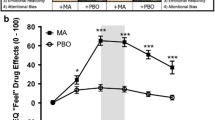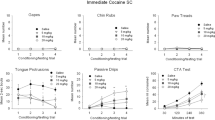Abstract
Recent experiments with human subjects have shown that drug cues (e.g. sight of beer or needle and syringe) elicit different responses than do neutral stimuli. However, because conditioning has not been carried out in the majority of cases, it is not clear why drug cues have different response eliciting capacities; associative and non-associative mechanisms may both play a part. In this experiment a counterbalanced differential conditioning procedure was used to isolate the role of associative processes in the development of physiological, behavioural, and subjective conditioned responses to cues for alcohol over the course of repeated conditioning sessions. Twelve healthy volunteers took part in the experiment which involved each subject attending for ten sessions. On physiological measures evidence was found for conditioning of skin conductance and cardiac inter-beat interval responses to cues for alcohol delivery. Over the course of conditioning on behavioural measures of drink consumption there were changes in the rate of consumption and number of sips taken as a function of whether or not the drinks contained alcohol. Finally, on subjective measures, there was a differential change in subjective state in response to alcohol and soft drink expectancy as conditioning progressed.
Similar content being viewed by others
References
Davey GCL (1992) An expectancy model of laboratory preparedness effects. J Exp Psychol Gen 121:24–40
Dawe S, Powell J, Richards D, Gossop M, Strang J, Marks I, Gray J (1993) Does post-withdrawal cue exposure improve outcome in opiate addiction? A controlled trial. Addiction 88:1233–1245
Dawson ME, Furedy JJ (1976) The role of awareness in human differential autonomic classical conditioning: the necessary gate hypothesis. Psychophysiology 13:50–53
Dawson ME, Grings WW (1968) Comparison of classical conditioning and relational learning. J Exp Psychol 76:227–231
Dawson ME, Schell AM (1987) Human autonomic and skeletal classical conditioning: the role of conscious cognitive factors. In: Davey G (ed) Cognitive processes and pavlovian conditioning in humans. Wiley, Chichester
de Wit H, Chutuape MA (1993) Increased ethanol choice in social drinkers following ethanol preload. Behav Pharmacol 4:29–36
Drummond DC, Glautier S (1994) A controlled trial of cue exposure treatment in alcohol dependence. J Consult Clin Psychol (in press)
Drummond DC, Cooper T, Glautier SP (1990) Conditioned learning in alcohol dependence: implications for cue exposure treatment. Br J Addict 85:725–743
Eysenck HJ, Eysenck SBJ (1975) Manual of the Eysenck personality questionaire. Hodder and Stoughton, London
Glautier S, Drummond DC (1994) Alcohol dependence and cue reactivity. J Stud Alcohol 55:224–229
Glautier S, Taylor C, Remington B (1992a) A method for producing alcohol placebos. Br J Addict 87:303–308
Glautier S, Drummond DC, Remington B (1992b) Different drink cues elicit different physiological responses in non-dependent drinkers. Psychopharmacology 106:550–554
Hodgson R, Rankin H, Stockwell T (1979) Alcohol dependence and the priming effect. Behav Res Ther 17:397–387
Hunt T, Amit Z (1987) Conditioned taste aversion induced by self administered drugs: paradox revisited. Neurosci Biobehav Rev 11:107–130
Lacey JI (1967) Somatic response patterning and stress: some revisions of activation theory. In: Appley MH, Trumbull R (eds) Psychological stress. Appleton-Century-Crofts, New York
Lovibond PF, Siddle DAT, Bond N (1992) Insensitivity to stimulus validity in human classical conditioning. Q J Exp Psychol [B] 40:377–410
Maltzman I, Gould J, Barnett OJ, Raskin DC, Wolff C (1977) Classical conditioning components of the orienting reflex to words using innocuous and noxious unconditioned stimuli under different CS-US intervals. J Exp Psychol Gen 106:185–212
McCaul ME, Turkkan JS, Stitzer ML (1989) Psychophysiological effects of alcohol related stimuli: I. the role of stimulus intensity. Alcohol Clin Exp Res 13:386–391
McLellen AT, Childress AR, Ehrman R, O'Brien CP (1986) Extinguishing conditioned responses during opiate dependence treatment: turning laboratory findings into clinical procedures. J Subst Abuse Treat 3:33–40
Mehrabian A, Russell JA (1974) Approach to environmental psychology. MIT Press, Cambridge
Niaura RS, Rosenhow DJ, Binkoff JA, Monti PM, Pedraza M, Abrams DB (1988) Relevance of cue reactivity to understanding alcohol and smoking relapse. J Abnorm Psychol 97:133–152
Paletta MS, Wagner AR (1986) Development of context specific tolerance to morphine: support for a dual process interpretation. Behav Neurosci 100:611–623
Pavlov IP (1927) Conditioned reflexes. Dover Publications Inc., 1960, New York
Powell J, Gray JA, Bradley BP, Kasvikis Y, Strang J, Barrat L, Marks I (1990) The effects of exposure to drug-related cues in detoxified opiate addicts: a theoretical review and some new data. Addict Behav 15:339–345
Rankin H, Hodgson R, Stockwell T (1983) Cue exposure and response prevention with alcoholics: a controlled trial. Behav Res Ther 21:435–446
Raw M, Russell MAH (1980) Rapid smoking, cue exposure and support in the modification of smoking. Behav Res Ther 18:363–372
Robbins SJ, Ehrman RN (1992) Designing studies of drug conditioning in humans. Psychopharmacology 106:143–153
Siegel S (1989) Pharmacological conditioning and drug effects. In: Goudie AJ, Emmett-Oglesby MW (eds) Psychoactive drugs: tolerance and sensitisation. Humana Press, Clifton, New Jersey, pp 115–180
Stewart J, de Wit H, Eikelboom R (1984) Role of unconditioned and conditioned drug effects in the self administration of opiates and stimulants. Psychol Rev 91:251–268
Stockwell TR, Hodgson RJ, Rankin HJ, Taylor C (1982) Alcohol dependence, beliefs and the priming effect. Behav Res Ther 20:513–522
Tucker JA, Vuchinich RA, Sobell MB (1982) Alcohol's effects on human emotions: a review of the stimulation/depression hypothesis. Int J Addict 17:155–180
Wagner AR (1981) SOP: a model of automatic memory processing in animal behavior. In: Spear NE, Miller RR (eds) Information processing in animals: memory mechanisms. Laurence Erlbaum, Hillsdale, New Jersey, pp 5–47
Wikler A, Frank K (1948) Hindlimb reflexes of chronic spinal dogs during cycles of addiction to morphine and methadone. J Pharmacol Exp Ther 94:382–400
Author information
Authors and Affiliations
Additional information
The work was supported by programme grant No. 7400 from the Medical Research Council
Rights and permissions
About this article
Cite this article
Glautier, S., Drummond, C. & Remington, B. Alcohol as an unconditioned stimulus in human classical conditioning. Psychopharmacology 116, 360–368 (1994). https://doi.org/10.1007/BF02245341
Received:
Revised:
Issue Date:
DOI: https://doi.org/10.1007/BF02245341




